What is a broken bone (fracture)?
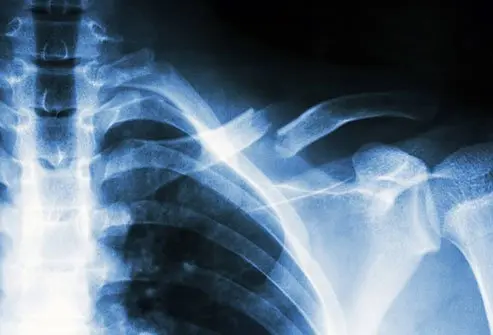
Bones make up the skeleton of the body. They allow us the ability to interact with our environment and lift our bodies against gravity. Bones are attachment points for muscles that allow us to run, jump, sit, kneel, grasp, and lift. Bones also protect organs from potential damage, and the bone marrow (tissue inside of bones) is responsible for blood cell production.
Bones are the body's storage area for calcium. On a cellular level, calcium is always entering and exiting bone under the influence of the body's hormones. Parathyroid hormone increases calcium levels in the bloodstream, meaning, that it regulates its release by bone and decreases bone density. Calcitonin decreases blood calcium levels and helps restore calcium to bone. Calcium is needed in the bloodstream to help muscle cells including the heart function. Hormone levels will sacrifice calcium in the bone to maintain blood calcium levels in a normal range. For that reason, calcium and Vitamin D are important to maintain calcium stores in the body.
What causes a broken bone?
When a bone has an outside force exerted upon it, like a blow or a fall, there is potential that it cannot withstand the amount of force and it breaks. That loss of integrity results in a fracture. It is important to remember that a fracture, break, or crack all describe the same situation, an injury to the bone where it has been damaged. One term is not more serious than another. Fracture, break, and crack all mean the same thing.
Depending upon the situation, the amount of force required may not be very great. In people with osteoporosis, the bones lack calcium and are brittle, a minor injury or even gravity may create enough of a force to cause a vertebral compression fracture of the back or a hip fracture.
What are the most common types of broken bones?
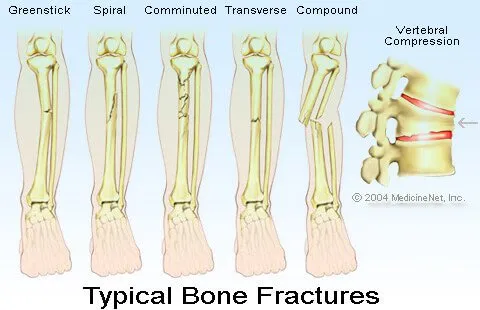
Fractures are usually described by their location, how the bones are aligned, whether there are associated complications with blood and nerve function, and whether the skin is intact at the injury site.
The terms and definitions used in medicine to describe fractures allow health care professionals to describe exactly where in the bone the fracture is located. For a reference point, the heart is considered the center of the body, and the anatomic descriptions are based on their location in the heart. When describing a location on or in the body, imagine standing straight up, looking forward with the arms slightly away from your side, and the palms turned forward.
Common anatomic terms used to describe fractures include the following:
- Proximal (closer to the center of the body) and Distal (further from the center): the elbow is proximal to the wrist and the wrist is distal to the elbow.
- Anterior (toward the front of the body) and Posterior (toward the back): The chest is anterior to the back and the back is posterior to the chest.
- Medial (toward the middle of the body) and Lateral (to the outer edge of the body): The ears are lateral to the nose and the nose is medial to the ears.
By thinking of the body in the anatomic position, fractures can be described by their location in the bone and how the parts are aligned and related to each other. Fractures are either displaced or non-displaced, meaning that they are adequately aligned or not. Some physicians suggest that all fractures have some displacement and prefer the term "minimally displaced."
The description of the fracture also includes the direction it takes within the bones.
- Transverse: the fracture travels across the bone
- Oblique: the fracture occurs at an angle
- Spiral: –the fracture spirals or extends down the length of the bone
- Comminuted: the fracture has more than two parts, and multiple fragments are present.
Special terms:
- Greenstick: In young children, the bones are not yet solid and when force is applied, it tends to bow and not break completely through. The term comes from a similar situation when trying to break a young branch off a tree.
- Torus: In children, when only one part of bone buckles it is called a torus or incomplete fracture.
- Open fracture: An open fracture describes the situation where the bone penetrates through the skin.
- The skin is very important in protecting the inside of the body from infection. If the skin overlying a broken bone is damaged, whether it is cut, torn, or scraped, there is potential for bacteria from the outside world to invade the broken bone and cause an infection.
Fractures are classified as open (if the skin is damaged) or closed (if the skin is intact). An open fracture may require an orthopedic surgeon to wash out the fracture site to prevent osteomyelitis (bone infection). Depending upon circumstances, the type of fracture, the amount of contamination to the skin and wound, and the person's condition, this procedure may take place in the operating room.

QUESTION
Emotional trauma is best described as a psychological response to a deeply distressing or life-threatening experience. See AnswerCompression fracture
The spine is comprised of 7 cervical, 12 thoracic, and 5 lumbar vertebrae. The spine holds the body erect against gravity to protect the spinal cord. Compression fractures can be caused by osteoporosis, injury, or trauma.
- People with osteoporosis lose calcium from the bones, and the vertebrae may become weak and unable to hold up against the forces of gravity, so they gradually compress over time.
- A compression fracture due to an injury may or may not have spinal cord or nerve root irritation because of the fracture.
- A compression fracture due to trauma most likely occurs from a motor vehicle crash or fall from height.
Skull fracture
The purpose of the skull is to protect the brain. It is a flat bone and it takes a significant direct blow to cause a fracture. Because the main concern is an injury to the brain and not the skull injury, plain X-rays are not routinely performed to look for a skull fracture. Instead, a CT scan of the brain is recommended if there is concern about a brain injury. Skull fractures are often associated with localized swelling and bleeding at the site of injury.
- Basilar skull fractures describe damage to bone at the base of the brain. Physical findings may include bloody drainage from the ear or nose, bruising behind the ear (Battle's sign), and bruising around the eyes (Raccoon eyes).
- With a depressed skull fracture, the bone is broken and fragments are pushed inward. Depending upon the depth of the bony depression and whether there is brain tissue involvement, surgery may be required.
- With an open skull fracture, the scalp is lacerated and the wound may connect with the fibrous coverings of the brain (meninges). Surgery is often performed to help prevent infection.
Health News
- Can AI Help Make IVF More Successful?
- Let's Address Tomorrow's Antivax Arguments Today: Pediatrics Expert
- The Public Policies That Really Help Prevent Suicide
- Gabapentin Doesn't Increase Fall Risk, Study Suggests
- Non-Opioids Can Ease Post-Dental Surgery Pain Better Than Opioids, Study Shows
 More Health News »
More Health News »
Stress fracture
Stress fractures are the result of multiple microtraumas where the bone cannot tolerate and absorb repeated stresses placed upon it. It is an overuse injury and is often seen in the lower leg, especially among runners and other athletes. If untreated, and if the person continues to participate in the offending activity, the stress fracture may progress to a completed fracture. These are most often seen in athletes who participate in running, tennis, basketball, and other sports that involve running and jumping on hard surfaces.
March fracture is the name given to a stress fracture of the metatarsal bone of the foot. They are described as soldiers who are forced to walk or "march" for prolonged distances.
What are the most common broken bones?
The most common fractures involve the clavicle (collarbone), the forearm (radius and ulna), the wrist, the ankle, and the hip. Closed fractures are more common than open fractures (the skin overlying the injury is intact and not damaged).
In children, a fracture of the distal radius is most common. The break occurs in the radius near the wrist but usually does not involve the joint itself. 1
Broken hand or fingers
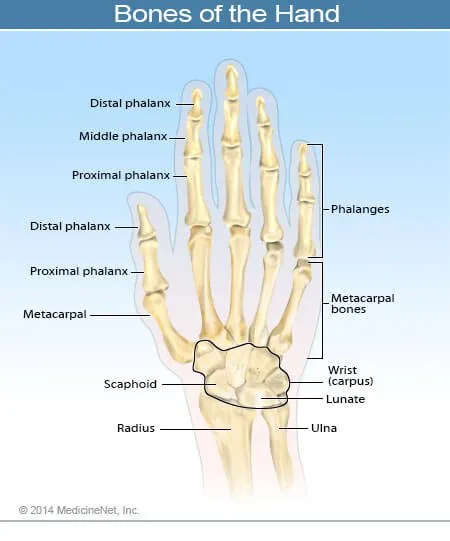
Injuries to the hands and fingers are very common because they are exposed in daily activities. In addition to the bones, the health care professional will be interested in making certain there are no tendon or nerve injuries associated with any broken bone(s). Because the anatomy of the hand is so complex, complicated fractures may be referred to an orthopedic or plastic hand specialist. Many of them will only require splinting or casting, but occasionally surgery will be necessary.
Broken wrist
Falling on an outstretched hand is the most common reason for a wrist fracture. It is often the distal radius (see illustration) that is damaged, and the fracture may involve more than one bone. Aside from the radius, wrist fractures may also include fractures of the carpal bones of the wrist (carpus), those that connect the radius to the long bones of the hand (metacarpals). Doctors often look for fractures of the scaphoid bone (the bone between the bottom of the thumb and the top of the radius), and dislocations of the lunate (the bone next to the scaphoid bone) that may be difficult to see on plain X-ray.
In some cases, the wrist is splinted even if X-rays are normal because upon physical examination the doctor may be concerned about a potential occult or hidden fracture (the fracture is so small that it does not show up on an X-ray).
Depending upon the bone that is injured and its alignment, surgery may or may not be required. Regardless of the treatment, the goal is to have a normally aligned wrist, especially if the fracture involves the joint surface. Poor alignment may lead to arthritis in the future.
Broken hip
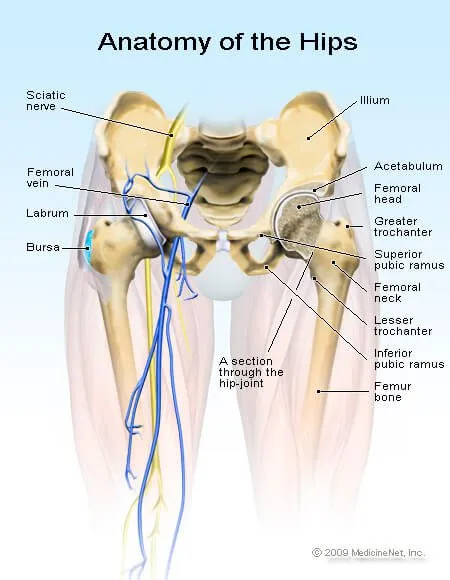
Hip fractures are perhaps the most common fracture seen in people 75 years of age or older. While falls and trauma may be the obvious cause, many times, people are more susceptible to hip fracture because of osteoporosis and sometimes the hip will break spontaneously.
The hip joint is made up of the interconnection of two bones in a ball and socket: 1) the socket in the pelvis (acetabulum), and 2) the ball (femoral head). Hip fractures refer to femur fractures.
Almost all hip fractures require surgery and the type of surgery depends upon where in the femur the fracture is located.
Subscribe to MedicineNet's Skin Care & Conditions Newsletter
By clicking "Submit," I agree to the MedicineNet Terms and Conditions and Privacy Policy. I also agree to receive emails from MedicineNet and I understand that I may opt out of MedicineNet subscriptions at any time.
Broken leg
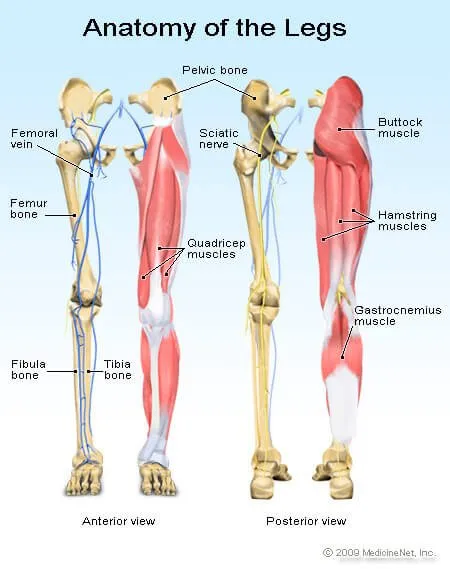
Each of the many bones of the lower extremity is at risk for fracture. Leg fractures also may involve the knee joint, and treatment depends upon the type of fracture. Similarly, fractures of the lower leg (tibia and fibula) and talus (the most proximal bone in the foot) may involve the ankle joint.
Fractures and dislocations of the foot may be as complex as the hand. Because of the anatomy, they may also be more difficult to diagnose on plain X-rays.
Broken toe
Broken toes are a common fracture and may be diagnosed by history and physical examination. X-rays may or may not be needed depending upon the clinical situation.
Broken shoulder
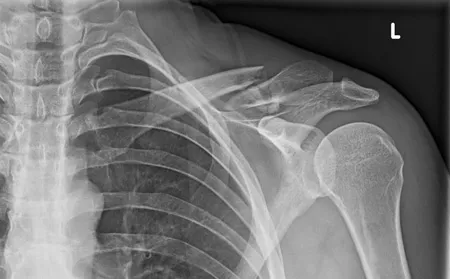
The clavicle (collarbone) fracture is one of the most commonly seen broken bones, fracture of the humeral head (the ball) is quite common in an older person who falls.
Depending upon the amount of comminution (into how many pieces the humeral head breaks) surgery may or may not be required. Initial treatment usually begins with a sling.
The scapula or shoulder blade is a flat bone and very difficult to break. The mechanism is usually a direct blow. Any scapula fracture needs to be evaluated for related injuries.
From 
Healthy Resources
What are the signs and symptoms of a broken bone?
Broken bones hurt. The lining of the bone (periosteum) is rich with nerve endings that can cause pain when inflamed, and the muscles surrounding the fracture go into spasm to prevent movement of the fracture site, and this spasm may intensify the pain.
Bones have a rich blood supply and will bleed when injured. This will cause swelling and the blood that seeps into the surrounding tissue will also cause further pain. The discoloration due to the blood can show up as dark red or purple bruises in the area of the fracture site.
Because muscles and tendons may not be damaged, the person may be able to move the injured extremity. For that reason, just because you can move the injured area, doesn't mean it's not broken.
If there is damage to a nearby artery, the injury may be cool and pale (distal to the injury), and if there is nerve damage, there may be numbness (distally).
How is a broken bone diagnosed?
Most broken bones require medical care but the urgency of that care depends upon the type of fracture and the circumstances.
- The doctor will take a history of the patient's injury, examine the injury, and look for potential other injuries that may have occurred.
- The skin surrounding the injured area is inspected to look for a laceration, scrape, or skin tear.
- The area of tenderness and swelling will be evaluated to identify the injured bone.
- The type of X-ray that is ordered depends on the specific injury.
- Sometimes plain X-rays do not identify the injury. If the doctor is still concerned, a CT scan or MRI might be ordered.
Fractures in children
Fractures may be difficult to diagnose in children because bones have not completely formed. Many parts of developing bone are comprised mostly of cartilage and have yet to have calcium deposited in them. Growing bone also has growth plates that may mimic or hide fractures. On occasion, the diagnosis of a fracture is made clinically based upon a physical exam, even if the X-rays do not show an injury.
What is the treatment for a broken bone?
The initial treatment of a fracture begins with stabilization and immobilization. In the field, RICE (rest, ice, compression, and elevation) may help make the patient more comfortable and prevent the fractured bones from moving. Often the pain associated with a fracture is due to spasms of the muscles surrounding the fracture site trying to prevent movement. Splinting may help relieve some of that pain. Depending upon the injury, EMS providers may consider traction to help with stabilization and pain control.
For non-open fractures or other fractures that can be treated without emergency surgery, the goal is to immobilize the injury to maintain anatomic alignment to allow the bone to heal.
Bone heals in three stages.
- Reactive stage: The blood clot that forms at the fracture site begins to organize and the body's building blocks start to bridge the gap between the two ends of the broken bone.
- Repair stage: Specialized cells located in the outer lining of the bone (periosteum), begin to form a latticework or grids of cartilage and bone, called a callus, which spans the fracture. More bone is laid down to provide strength to the area.
- Remodeling phase: Over the next few years, the body will attempt to resculpt this mass of bone into its original size and shape.
In the emergency department, walk-in clinic, or doctor's office, the extremity is usually splinted using a combination of soft padding, casting material (plaster, fiberglass), and ace wraps. This splint is not circumferential like a cast, because a fracture has the potential for swelling of the surrounding tissues, and if a tight cast were in place, that swelling could cause complications including significant pain and potential blood supply issues.
Once the patient is discharged, their instructions are to elevate the injury and ice the area, even with the splint, to help decrease swelling and inflammation.
After a few days, once the initial swelling has resolved, a circumferential cast may replace the splint and will be worn until the fracture is healed. The time frame for healing depends upon the type of fracture and its location. X-rays may be used to help determine when it is time for the cast to be removed.
Finger and hand fractures may be more complicated. The hand is a complex web of tendons, blood vessels, and nerves that allow fine motor function. What might be acceptable healing and alignment in an arm or leg may not be appropriate in a hand. Some finger injuries need nothing more than a metal splint or buddy taping one finger to another for support, while others will need surgery. The type of treatment will depend upon the type of injury.
Most toe injuries heal very well own and need nothing more than buddy taping one toe to another for support.
The treatment for rib fractures involves pain control so that the patient can take deep breaths and allow the lung to expand beneath the injury site to prevent pneumonia. Rib injuries are not wrapped or bandaged to help with pain control because this will limit their movement, and prevent lung expansion. Because of this, rib fractures generally take 4 to 6 weeks to heal and may cause pain throughout the healing process.
What about surgery for a broken bone?
The decision to operate on a fracture depends upon the type of fracture, whether it can heal in good alignment on its own, and whether other potential complications exist.
Sometimes patients are taken to the operating room for a closed reduction (resetting of the bone) and splinting of the fracture. When a fracture is markedly displaced and misaligned, it may be too painful to move or manipulate the bone without an anesthetic.
If it appears that the fracture is unstable and cannot be held in place and good alignment with just a splint or cast, an open reduction and internal fixation (ORIF) may be needed. An incision is made so that the bony pieces can be identified and aligned. Metal plates and screws, wires, or rods may be used to stabilize the fracture. The hardware may be left in place forever or it may be there only temporarily until the fracture heals. Hip fractures almost always require ORIF to allow the patient to heal and regain the ability to walk.
Surgery may be required in situations where there is associated injury to arteries and nerves and they need to be repaired or decompressed.
Open fractures often have to go to the operating room to be washed out to prevent infection of the bone (osteomyelitis).
What is the prognosis for a broken bone?
Fractures are a common injury, but the prognosis depends upon the bone that is broken, the location of the break, whether any complications exist, and the underlying medical condition of the individual. Most arm and leg fractures heal well, and the goal is for the person to return to their baseline level of activity.
How can broken bones be prevented?
Many broken bones occur because of accidents in the home, at work, or play, and not all may be preventable. Using proper safety equipment and precautions may minimize the risk of injury, but it cannot be eliminated.
As we age, there is an increased risk for falls at home and some preventive steps may help reduce fall risks. These include:
- Make certain that lighting is adequate
- Shoes should not be slippery
- Loose rugs or uneven floors should be repaired
- High traffic areas like from the bed to the bath or from the kitchen to the living area need to be clear from hazards like excess furniture, extension cords, or boxes
- Bathrooms should have nonslip mats on the floor and in the bathtub or shower
- Install handrails for stairs and grab bars in the bathroom
Bones also get old as we age and the management of osteoporosis is a life-long commitment. Increasing calcium content in the bone will decrease the risk of spontaneous fracture, and also may make the bone strong enough to potentially withstand an injury that otherwise would result in a fracture. Ways to prevent osteoporosis include:
- Increase weight-bearing exercise
- Make sure you are getting the right amount of calcium and Vitamin D in the diet. Take supplements if necessary.
- Do not smoke
- Avoid excess alcohol intake
Top Broken Bone (Types of Bone Fractures) Related Articles

Broken Bones
Broken bones are a common type of injury. Bones are some of the hardest tissues in the body, but they can break when they are stressed. Osteoporosis and cancer may cause bone fractures. The broken bone needs immediate medical treatment.
Chest Pain
Chest pain is a common complaint by a patient in the ER. Causes of chest pain include broken or bruised ribs, pleurisy, pneumothorax, shingles, pneumonia, pulmonary embolism, angina, heart attack, costochondritis, pericarditis, aorta or aortic dissection, and reflux esophagitis.
Diagnosis and treatment of chest pain depends upon the cause and clinical presentation of the patient's chest pain.

Chest X-Ray
Chest X-Ray is a type of X-Ray commonly used to detect abnormalities in the lungs. A chest X-ray can also detect some abnormalities in the heart, aorta, and the bones of the thoracic area. A chest X-ray can be used to define abnormalities of the lungs such as excessive fluid (fluid overload or pulmonary edema), fluid around the lung (pleural effusion), pneumonia, bronchitis, asthma, cysts, and cancers.
Common Medical Abbreviations & Terms
Doctors, pharmacists, and other health-care professionals use abbreviations, acronyms, and other terminology for instructions and information in regard to a patient's health condition, prescription drugs they are to take, or medical procedures that have been ordered. There is no approved this list of common medical abbreviations, acronyms, and terminology used by doctors and other health- care professionals. You can use this list of medical abbreviations and acronyms written by our doctors the next time you can't understand what is on your prescription package, blood test results, or medical procedure orders. Examples include:
- ANED: Alive no evidence of disease. The patient arrived in the ER alive with no evidence of disease.
- ARF: Acute renal (kidney) failure
- cap: Capsule.
- CPAP: Continuous positive airway pressure. A treatment for sleep apnea.
- DJD: Degenerative joint disease. Another term for osteoarthritis.
- DM: Diabetes mellitus. Type 1 and type 2 diabetes
- HA: Headache
- IBD: Inflammatory bowel disease. A name for two disorders of the gastrointestinal (BI) tract, Crohn's disease and ulcerative colitis
- JT: Joint
- N/V: Nausea or vomiting.
- p.o.: By mouth. From the Latin terminology per os.
- q.i.d.: Four times daily. As in taking a medicine four times daily.
- RA: Rheumatoid arthritis
- SOB: Shortness of breath.
- T: Temperature. Temperature is recorded as part of the physical examination. It is one of the "vital signs."

CT Scan vs. MRI
CT or computerized tomography scan uses X-rays that take images of cross-sections of the bones or other parts of the body to diagnose tumors or lesions in the abdomen, blood clots, and lung conditions like emphysema or pneumonia. MRI or magnetic resonance imaging uses strong magnetic fields and radio waves to make images of the organs, cartilage, tendons, and other soft tissues of the body. MRI costs more than CT, while CT is a quicker and more comfortable test for the patient.
Feet Facts Quiz
Did you know that certain shoes and common diseases can wreak havoc on your feet? If you've been having problems with your feet, this quiz is for you.
Foot Health: Causes of Swollen Feet and Ankles
Swollen feet and ankles may be associated with conditions like pregnancy, injury, heart failure, kidney disease, liver disease, chronic venous insufficiency, and lymphedema. Treatment may include home remedies, exercise, magnesium, and certain medications.
Gluteal Injury
Falls or blows are the most common cause of gluteal injuries. Symptoms and signs of a gluteal injury include swelling, inflammation, bleeding, and redness. Treatment options may incorporate ice application, elevation, rest, physical therapy, and on occasion, surgery.
Hematoma
A hematoma is a collection of blood that is outside a blood vessel. There are different areas where hematomas occur including; inside the skull, on the scalp, ears, septum, bones, fingernails, toenails, and intra-abdominal.
How Do You Treat Saphenous Nerve Pain?
Saphenous nerve block is a type of anesthetic procedure that blocks the saphenous nerve, a pure sensory nerve of the leg, to anesthetize the lower extremity. This kills the pain during surgery for various conditions, but other longer-lasting treatments are used for chronic pain in the saphenous nerve.
Internal Bleeding
Internal bleeding is a serious consequence of trauma and can be life-threatening, requiring immediate medical attention. Learn about signs, causes, and treatment.
Knee Joint Picture
The knee joint has three parts. See a picture of Knee Joint and learn more about the health topic.
MRI (Magnetic Resonance Imaging Scan)
MRI (or magnetic resonance imaging) scan is a radiology technique which uses magnetism, radio waves, and a computer to produce images of body structures. MRI scanning is painless and does not involve X-ray radiation. Patients with heart pacemakers, metal implants, or metal chips or clips in or around the eyes cannot be scanned with MRI because of the effect of the magnet.
Osteoporosis Slideshow
Osteoporosis is a disease characterized by low bone mass and density. Osteoporosis causes symptoms of weak, thin, fragile bones. Learn the treatments and medications used to fight osteoporosis, as well as prevention tips.
Sports Injuries: Types, Treatments, and Prevention
Weekend warriors and professionals alike all experience sports injuries. See how to prevent strains, sprains, and tears with proper form, stretching, and more.
X-Rays
X-rays are a powerful form of electromagnetic radiation that can pass through solid objects. In medicine, X-rays are used to obtain an image of a part of the body. X-rays are necessary to diagnose many illnesses, for example, tumors, arthritis, dental problems, digestive or heart problems, and bone fractures. The side effects, dangers, and risks of having X-rays while pregnant or breastfeeding are provided.